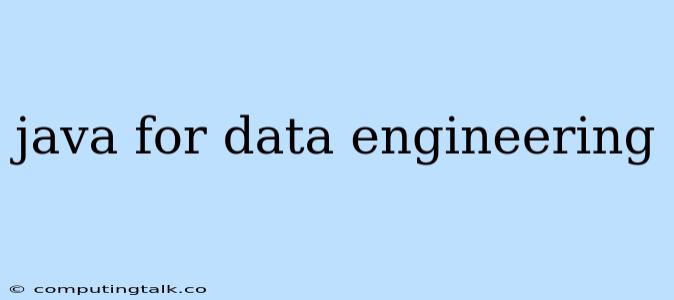Java is a popular and powerful programming language that is widely used in data engineering. It offers a range of features and libraries that make it well-suited for handling large datasets, performing complex data transformations, and building robust data pipelines.
Why Java for Data Engineering?
Java's popularity and widespread adoption in the enterprise world make it a natural choice for data engineering projects. Many organizations already have Java infrastructure in place, and there is a large pool of experienced Java developers available.
Java's maturity and extensive libraries provide a solid foundation for building reliable and scalable data engineering solutions. It offers a wide range of libraries and frameworks, including:
- Apache Spark: A powerful open-source distributed processing framework that enables parallel and distributed data processing.
- Apache Kafka: A high-throughput, distributed streaming platform for real-time data ingestion and processing.
- Apache Hadoop: A framework for storing and processing large datasets in a distributed manner.
- Apache Hive: A data warehouse system built on top of Hadoop that provides SQL-like query capabilities.
- Spring Boot: A framework that simplifies the development and deployment of Java applications, including data engineering applications.
Java's type safety and compile-time error checking help ensure code quality and reduce the likelihood of bugs, which is critical for data engineering projects where data integrity is paramount.
Java's performance and scalability make it ideal for handling large datasets and high-volume data processing.
Key Concepts in Java for Data Engineering
Data Structures
Java provides a rich set of data structures that are essential for data engineering, including:
- Arrays: A fixed-size collection of elements of the same data type.
- Lists: A dynamic collection of elements that can be added or removed.
- Sets: A collection of unique elements that can be used to represent sets of data.
- Maps: A collection of key-value pairs that can be used to store and retrieve data based on a key.
Data Types
Java supports a variety of data types, including:
- Primitive Data Types: Basic data types like integers, floating-point numbers, and booleans.
- Reference Data Types: Data types that refer to objects, such as arrays, lists, and maps.
Object-Oriented Programming (OOP)
Java is an object-oriented programming language, which allows you to model real-world objects and their relationships. OOP concepts, such as classes, objects, inheritance, and polymorphism, are essential for building modular and reusable data engineering components.
Examples of Java in Data Engineering
Data Processing with Spark
import org.apache.spark.sql.Dataset;
import org.apache.spark.sql.Row;
import org.apache.spark.sql.SparkSession;
public class SparkDataProcessing {
public static void main(String[] args) {
// Create a SparkSession
SparkSession spark = SparkSession.builder()
.appName("SparkDataProcessing")
.getOrCreate();
// Load data from a file
Dataset data = spark.read().csv("path/to/data.csv");
// Perform data transformations
Dataset transformedData = data.filter("age > 30")
.select("name", "age");
// Write the transformed data to a file
transformedData.write().format("parquet").save("path/to/output.parquet");
// Stop the SparkSession
spark.stop();
}
}
This example demonstrates how to use Spark to load data from a CSV file, perform data transformations using filtering and selection, and save the transformed data to a Parquet file.
Data Streaming with Kafka
import org.apache.kafka.clients.producer.KafkaProducer;
import org.apache.kafka.clients.producer.ProducerRecord;
import org.apache.kafka.common.serialization.StringSerializer;
import java.util.Properties;
public class KafkaDataStreaming {
public static void main(String[] args) {
// Set up Kafka producer properties
Properties props = new Properties();
props.put("bootstrap.servers", "localhost:9092");
props.put("key.serializer", StringSerializer.class.getName());
props.put("value.serializer", StringSerializer.class.getName());
// Create a Kafka producer
KafkaProducer producer = new KafkaProducer<>(props);
// Send data to Kafka topic
for (int i = 0; i < 10; i++) {
String message = "Message " + i;
producer.send(new ProducerRecord<>("my-topic", message));
}
// Close the Kafka producer
producer.close();
}
}
This example shows how to use Kafka to produce data to a specific topic. The code creates a Kafka producer, sets up the necessary properties, and sends a series of messages to the "my-topic" topic.
Java Libraries and Frameworks for Data Engineering
Apache Spark
Apache Spark is a powerful open-source framework for distributed data processing. It provides a variety of APIs for different programming languages, including Java. Spark offers features like:
- Data Ingestion: Load data from various sources, including files, databases, and streaming platforms.
- Data Transformation: Perform complex data transformations, such as aggregations, joins, and filters.
- Data Analysis: Analyze data using SQL queries and machine learning algorithms.
- Data Visualization: Create interactive dashboards and visualizations from data.
Apache Kafka
Apache Kafka is a distributed streaming platform that enables real-time data ingestion and processing. It offers features like:
- High Throughput: Handle large volumes of data at high speeds.
- Durability: Ensure data persistence even in the event of failures.
- Scalability: Easily scale to handle increasing data volumes.
- Fault Tolerance: Tolerate failures and ensure data continuity.
Apache Hadoop
Apache Hadoop is a framework for storing and processing large datasets in a distributed manner. It consists of two main components:
- Hadoop Distributed File System (HDFS): A distributed file system for storing large datasets.
- Hadoop YARN (Yet Another Resource Negotiator): A resource management system for running distributed applications.
Apache Hive
Apache Hive is a data warehouse system built on top of Hadoop. It provides a SQL-like query language (HiveQL) for querying data stored in HDFS.
Spring Boot
Spring Boot is a framework that simplifies the development and deployment of Java applications. It provides features like:
- Auto-configuration: Automatically configure application dependencies based on project dependencies.
- Embedded servers: Run applications without external web servers.
- Starter dependencies: Provide pre-configured dependencies for common use cases, including data engineering.
- Actuator endpoints: Provide monitoring and management endpoints for applications.
Conclusion
Java is a powerful and versatile programming language that is well-suited for data engineering. Its maturity, libraries, and performance make it a popular choice for building robust and scalable data pipelines. With its wide range of libraries and frameworks, Java enables developers to tackle complex data engineering challenges and build efficient data-driven solutions.
